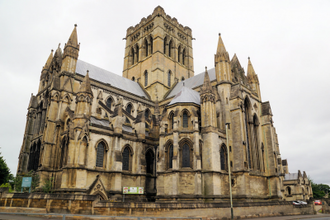Annual report shows positive picture for Diocese of East Anglia

St John's Cathedral Image Keith Morris
Source: Diocese of East Anglia
The Annual Report and Accounts of the Diocese of East Anglia have just been published online and show that with churches reopening, but Covid precautions still in place, church attendance and provision of the Sacraments recovered strongly in the course of 2021.
The number of baptisms was up 81%, the number of marriages more than doubled and total in-person Mass attendance rose by over a third to 12,611.
Key Objectives
The key aims for the year were:
- Maintenance of parish life and communities, responding effectively to the continuing Covid-19 pandemic.
- To assist parishes and school governing bodies in the financing and control of major building projects and to mitigate the impact of the pandemic on these projects.
- To expand the number of Catholic schools to reflect increased demand for Catholic education
- Application of funds raised by the Alive in Faith campaign to support the training of new priests and deacons, to make provision for priests who are retiring, and engaging in a variety of parish projects.
Charitable Activities
Significant charitable activities included:
- The provision of sacramental and social outreach, including improving digital access to services and parish groups;
- Parishes and church groups delivered projects such as food parcels to support those still impacted by the pandemic and St John's Cathedral's initiative in providing night shelter accommodation for the homeless;
- Other social outreach projects included funding the provision of move-on housing for single homeless men and debt crisis support.
- St John Henry Newman school - work started on site in 2021, funded through a combination of DfE, Peterborough City Council and Diocesan funding.
- The new Sacred Heart school, Swaffham, opened in 2021, with significant funding from the Diocese of £181,000 in 2021 and over £600,000 from DfE;
- Urgent repairs at St John's Cathedral, St Mary's Church in Great Yarmouth, and St Peter the Apostle in Gorleston carried out in 2021 with Historic England grant funding.
- Continued recruitment, education and training of priests and deacons, with the addition of three priests to the Diocese and the ordination of one new priest during the year, while eight seminarians and three candidates for the permanent diaconate were in training.
By the end of 2021, 80% of parishes have begun to draw down funding for projects established as a result of the Alive in Faith appeal. These range from refurbishment and repairs for church buildings, to installation of photovoltaic panels in schools, to supporting young people and the elderly, to helping the homeless or to support family life. The total amount pledged to Alive in Faith stands at over £6.3 million.
Statistics
Although churches were reopened during 2021, Covid precautions remained in place and the Sunday Mass obligation was not imposed during the year. Nevertheless, active church attendance and provision of the Sacraments recovered strongly in the course of the year, with the number of baptisms up 81%, and the number of marriages more than doubling year-on-year. Total in-person Mass attendance rose by over a third to 12,611.
The total Catholic population in the area covered by the Diocese is estimated to be some 140,000.
The significant contribution provided by volunteers is recognised with an estimated 1900 volunteers taking on roles such as catechists, stewards, parish treasurers, committee members, flower arrangers and lay ministers.
At the start of 2021, there were 94 active priests, 28 active permanent deacons, eight seminarians in training and three students for the permanent diaconate.
Future Plans
Priests: Efforts across the Diocese have resulted in an increase in the number of vocations to the priesthood, the permanent diaconate and the religious life and the number of priests available comfortably exceeds the number of parishes. Meeting the needs of the increasing numbers of priests reaching retirement age or retiring on the grounds of ill health is a significant challenge for the Diocese.
Buildings: Annual reviews of mass attendance in parishes help measure which churches and buildings may need expansion or new buildings and those where a church or building may be underutilised.
Particular attention is being given to those churches that are presently on Historic England's "Heritage At Risk" register. Grants for three such churches were received in 2021.
Mission: The Trustees remain focused on their core purpose, to advance the Catholic faith in East Anglia. Trustees have supported parishes and schools in recovering from the restrictions imposed on church activity during the pandemic and have seen that bear fruit in a renewal of events and pilgrimages, increases in Mass attendance, and a fuller provision of activities in schools.
Safeguarding: The Trustees continue to place safeguarding at the heart of their responsibilities and will ensure that safeguarding provision and training in the diocese is appropriate.
Financial Performance
The total income of the Diocese increased from £6.08m to £6.38m during the year. Total expenditure for the Diocese also increased, from £6.06m in 2020 to £6.3m in 2021.
Unrestricted parochial income was £4.97m (2020: £4.3m), with £4.2m (2020: £3.8m), from donations, legacies and grants. Total parochial costs were £3.93m (2020: £3.4m).
At 31 December 2021, the Diocese's reserves, including parishes, stood at £34.7m. Of this, £5m is restricted to particular uses and £3.5m has been designated by the Trustees for certain specific purposes.
Of the remaining reserves, parochial funds amount to £22.9m, of which £14.4m is represented by fixed assets in the form of churches and other property
General reserves at the Diocese increased from £3.37m to £3.38m
Click here to download and read the full ARA for 2021. www.rcdea.org.uk/annual-report-and-accounts/


















